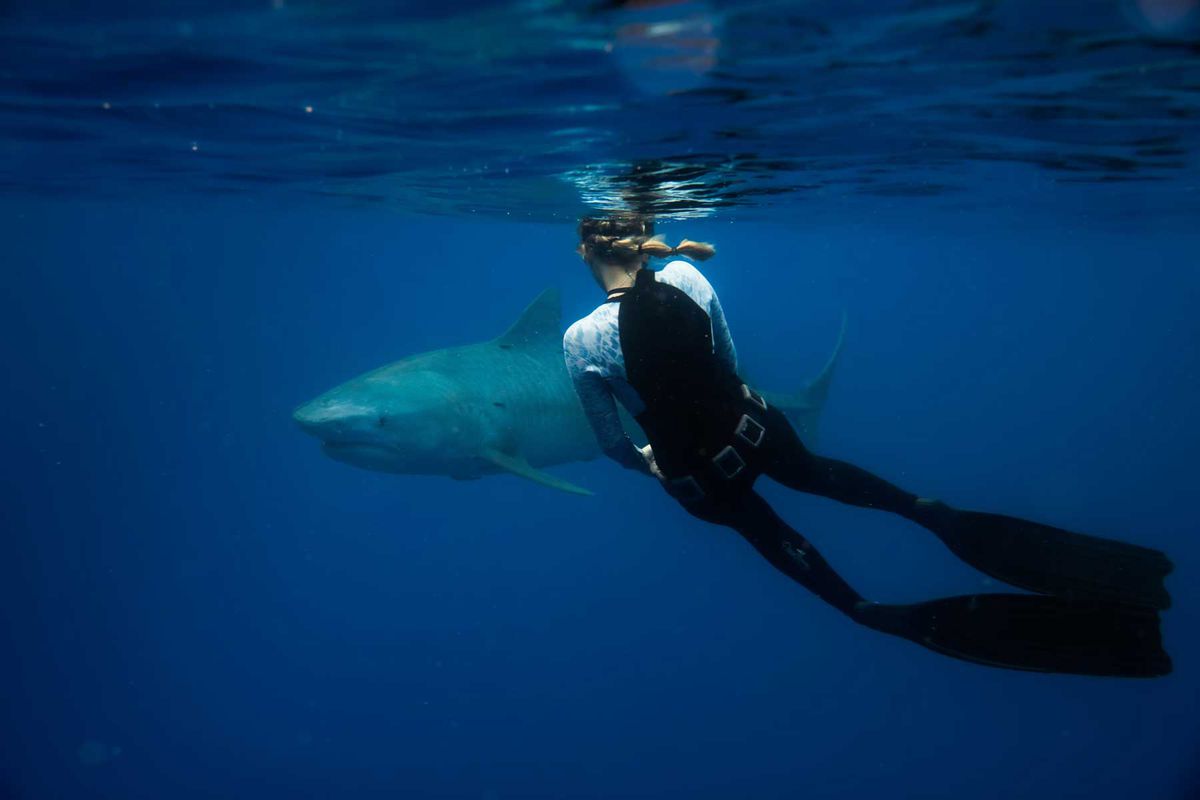11 Tips to Keep You Safe From Sharks, According to a Shark Safety Diver
When you're paddling around in the ocean, sharks may enter your mind more often than you'd like to admit. And while these creatures have been painted as heartless predators on the hunt for human blood (thanks, Jaws), that couldn't be further from the truth. Sharks are intelligent and curious animals who are likely just as intimidated by you as you are of them. If you ever run into one in the ocean, the success of your interaction largely depends on you — it's up to you to convey that you are a predator, not prey.
Taylor Cunningham, a marine biologist and shark conservationist who works as a shark safety diver with One Ocean Diving, tells Travel + Leisure, "People need to understand that the ocean is home to an abundance of wildlife, not just sharks. By entering the ocean, we are taking on the responsibility of entering their home. So, it is also our responsibility to be aware of our effects on the ocean and how that wildlife or conditions can affect us."
And while keeping cool when nose to nose with a shark may seem impossible, it isn't. You just need to know a little about shark behavior and have a plan for how to react should you come across one while swimming. After all, as Cunningham says, "Falling coconuts kill more people than sharks, and no one is afraid of falling coconuts."
Research local shark patterns.
During certain times of the year, some shark species come closer to shore to pup in the warm coastal waters. In Hawaii, for example, tiger sharks swim close to shore in the late summer and early fall to give birth, Cunningham says. She notes that this pattern "varies by species and place, but it can be helpful to know your local shark patterns so you can choose your in-water activities wisely."
Bring a mask and fins on long swims.
You don't need to wear a mask and fins every time you step foot in the ocean, but if you're heading out on a long swim and are worried you might run into a shark, it may pay to bring along the right gear. "Both of these items allow you to be more aware of your surroundings, which is key to being safe in the ocean," says Cunningham.
Leave the white bikini at home.
Believe it or not, when it comes to sharks, the color of your clothing and gear matters. "Sharks have monochromatic vision, so it would be smart to avoid colors like white, yellow, and/or neon when swimming or diving because those may stand out more brightly in a blue ocean. Sticking to darker colors, like black and blue, can minimize unwanted attention from sharks," Cunningham explains.
Don’t worry if you have a cut — sharks don’t react to human blood.
Yes, you read that right. The longtime belief that sharks, who have a great sense of smell, are drawn to human blood is false. "Sharks do not react to human blood or scent," says Cunningham. "Scientists have done studies in which they have found that sharks have minimal to no reaction in the brain to humans."
Act like a predator by constantly checking your surroundings.
Sharks will wait until they find an animal's blind spot before they approach. You can convey that you're a predator, not prey, by continuously turning and looking around when you're in the water — be it as a diver, swimmer, or surfer. Cunningham explains that this "can help you appear more aware (like another predator), and therefore you will be less likely to be approached by a shark."
Make eye contact if you see a shark.
When you see a shark, your instinct may be to swim as fast as you can in the other direction, but this could communicate that you are prey and should be chased. When you spot a shark in the ocean, your goal is to let them know that you, too, are a predator. To do this, you must "acknowledge the shark by using eye contact," says Cunningham, who further explains on her blog that, "The only thing that actively tracks animals in the ocean is a predator. By showing your awareness and confidence in making eye contact with the sharks, you assert yourself as a predator."
While making eye contact is key to establishing yourself as a predator, don't get too locked in. Cunningham warns, "If there's one shark, there could be others." So, after you make initial eye contact, look around for other sharks. Again, the key is to show the shark or sharks that you are aware of them and not prey.
Create space between you and the shark.
This is where those fins come in handy. If the shark is getting closer, use your fins, GoPro, or any solid items you have on you to create space between you and the animal. On her blog, Cunningham explains, "As you move your fins away from you and toward the shark, you are sending some water in their direction. They will likely pick this up on their lateral line and turn away…It additionally gives the shark some[thing] inanimate to bump."
Slowly back away after you’ve made eye contact, but avoid splashing and making noise.
The reason you want to act like a predator in the water is to tell the shark that you are not on their menu. Splashing, screaming, and causing a scene at the surface might make them think you are a sick or injured bird or fish — things that are on their menu.
"It is a good rule of thumb to avoid acting and/or looking like anything a shark could mistake as prey," says Cunningham. "Avoid erratic movements and splashing like a sick or injured animal. Act like a predator, not prey."
Note the shark’s body language.
"Sharks are not inherently 'aggressive,' but they can be territorial or competitive," explains Cunningham. "Sharks will use their body language prior to any physical confrontation. If you notice a shark is dropping its pectoral fins (like when a cat arches its back) or holding its mouth open (like when a dog snarls), slowly back away, give it space, and exit the water."
Remember that sharks swim by and ignore people all the time.
Most people assume that if there's a shark in the water, they'd know about it, but in reality, Cunningham says sharks swim by and ignore people all the time, much like any other fish. Over the years, drone footage has shown sharks within feet of people who had no idea they had company. Most of the time, sharks are just checking out the scene.
Above all, don’t panic.
The key to getting through any shark encounter is to act like a predator. And if you're too busy panicking and calling extra attention to yourself, there's no way the animal is going to believe you could potentially be a threat to them. Cunningham says, "Sharks do not see people as a prey item. More often than not, sharks completely ignore humans in the ocean."
If you're looking to take your understanding of sharks to the next level, there are plenty of resources on the One Ocean Diving site — including cofounder Ocean Ramsey's book, "What You Should Know About Sharks," and her digital course, Guide to Sharks and Safety, which provides in-depth information on behavior and safety in the water.
Source: Read Full Article




